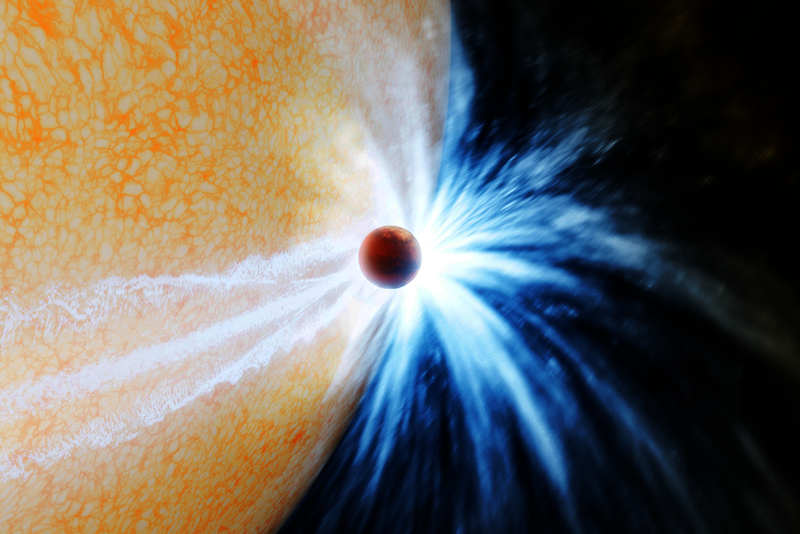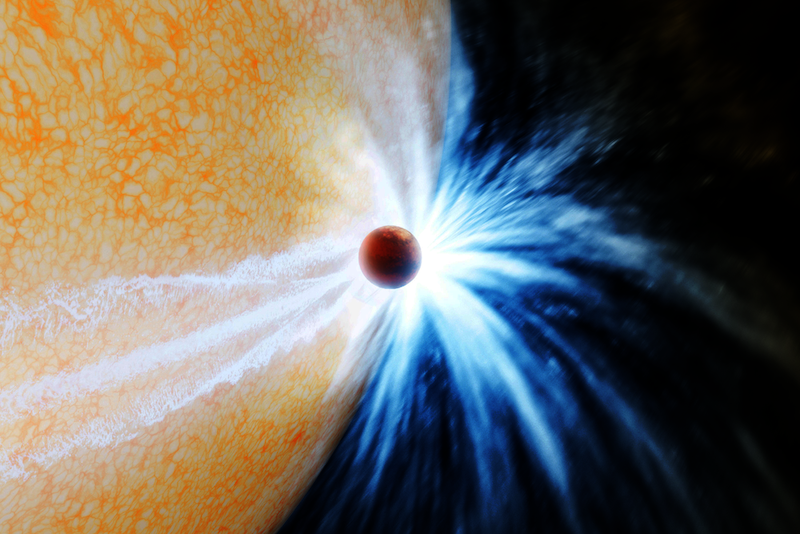Astronomers Capture a Star Swallowing a Planet
When our Sun nears the end of its life, it will start to swell. During this expansion, which is expected to happen in some 6 billion years, the dying Sun will engulf our Solar System’s inner planets, including Earth. Though scientists are certain of Earth’s far-future fate, no direct observation had been made of a dying star swallowing an orbiting planet, until now [1].
The unique observation comes from Kishalay De of the Massachusetts Institute of Technology and his colleagues. The team found the planet-eating star in data taken as part of the Zwicky Transient Facility (ZTF), a large-area optical survey of the night sky. While comparing a few weeks’ worth of consecutive ZTF scans—a new survey of the sky is performed every 48 hours—a brightening star 12,000 light-years from Earth caught De’s attention, he says.
After spotting the star, De and his colleagues checked to see whether what they had spotted was a nova—a star that suddenly increases in brightness before fading away to its former obscurity. They quickly ruled that possibility out; during a nova, a star expels a hot gas of atoms, but the data indicated the presence of molecules, which only exist at cold temperatures. Also, data from NASA’s NEOWISE telescope—an infrared space telescope that is being used to find asteroids and comets—revealed that the star had started getting brighter months before the outburst; a nova would brighten on a much shorter timescale.
Together, De says that these observations fit those expected for a stellar merger—the collision of two stars—except that the signals are between 100 and 1000 times fainter than predicted for such an event. This observation led the researchers to conclude that the signal they had spotted was coming from the merger of a star with a much lighter object, one with a mass on the order of that of a gas giant, such as Jupiter or Saturn. De says, that’s when the team members realized they’d seen a star engulfing a planet.
In our Solar System, Earth won’t get swallowed by the Sun until the Sun reaches the so-called red giant phase of its life cycle, which will happen when the Sun runs out of hydrogen fuel and expands to roughly 100 times its present size. The planet-swallowing star that De and his colleagues spotted is a “main sequence” star—it’s in the same life cycle phase as our Sun is now. So, what caused the star to swallow a planet?
The data from NEOWISE suggest that the star De spotted began bloating a few months prior to it engulfing the planet, indicating that the star has started running out of fuel. This bloating was eventually enough for the star to swallow the planet, a process that hastened the bulging and led to the star swelling to 4 times its initial diameter. As the star swallowed the planet it also belched gas from its outer layers, creating the molecular dust cloud that De and his colleagues observed with ZTF.
Alexander Stephan, an astrophysicist at Ohio State University, says it’s great to see a previously only theorized event. “We can now finally study [stars eating planets] in vivo,” he says. De and his colleagues are already planning more research exactly along those lines. Those studies will involve conducting further observations of this star with other telescopes so that the team can gather as much information about the event as possible.
–Allison Gasparini
Allison Gasparini is a freelance science writer based in Santa Cruz, CA.
References
- K. De et al., “An infrared transient from a star engulfing a planet,” Nature 617, 55 (2023).





